We must admit that we didn’t expect non-reference cooling with two large fans and a large heatpipe cooler for the price of a reference GTX 260 card. Add to that the fact that the card is overclocked, and you’ll be going trough serious dilemma whether to replace your current card. The card is available for €215 here.
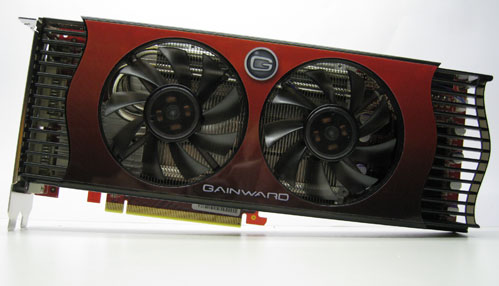
Let us remind you a bit of what this card is all about. GTX 260 has gone through numerous changes in the last three months. We’re all growing weary of constant renaming of cards, which results in better sales due to unsuspecting consumers’ lack of knowledge, but with its GTX 260 Nvidia did a much better move. The company rolled out a faster card with more shader processors (216 SPs instead of 192), and additionally juiced up the drivers, which greatly benefited gaming. As a result, the new GTX 260 with 216 SPs leaves its competitor, Radeon HD 4870 1GB, behind in many tests.
Nvidia is planning to keep "improving" the design as we currently know it, and we’re talking about redesigning a PCB, which should result in lower production costs. By the end of last year, the GTX 260 got a smaller and cheaper 55nm chip, and at the same time Nvidia started using the new P654 design that replaced the older P651, which housed the 65nm GT200 chip. Initial design featured 14 layers, the current has 10 whereas the new P897 PCB design will feature only 8 layers. You’ll easily tell the future design as the PCB is 1.5cm shorter.
Fortunately, Gainward didn’t go to those lengths to shorten the PCB but the company did use cheaper components, such as Realtek’s voltage regulator, which doesn’t support software voltage changes. Additionally, the question of whether anyone among average users has ever even heard of Volterra voltage regulator featured on the initial reference PCB, is probably a retorical question. An average user’s only concern is that the GTX 260 Golden Sample runs stable and is faster than the reference card, but many users ended up buying the renamed cards, all the while thinking it’s a new product they’re holding in their hands.
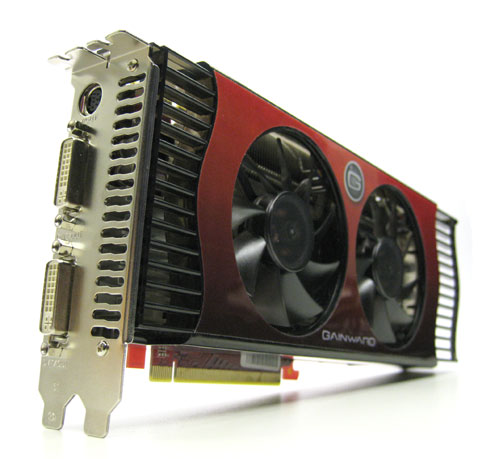
Although most GTX 216 cards we’ve seen so far come with reference cooling and PCB, Nvidia allowed its add-in board partners to create PCBs and coolers to their liking. Note however that reference cooling does a good job as well, and doesn’t run too loud.
Gainward took up Nvidia on this, and added its own cooling (at the same time with Palit). Golden Sample card got new looks, and at the same time the PCB went through some changes. The whole card got a nice red color, and at first glance we’d almost say it’s a Radeon. You might remember the card we reviewed in November, the Rampage 700 (Gainward HD 4870 X2 version), whose cooling reminds us of GTX 260 GS’s. Fortunately, we’ve had no complains – it runs like a charm.
The cooler seems a bit larger than the reference one and makes the card look longer, but it’s exactly two slots wide and about 27 centimeters long, just like the reference card.
Compared to the reference card, Gainward’s card is much cooler, keeping the temperatures at about 67 degrees Celsius when under a workload (reference cards run at about 77 degrees Celsius) and about 45 degrees Celsius in idle mode (similar to reference cards’ temperatures). That settled, as long as it’s not loud in idle and workload modes – we’re happy.
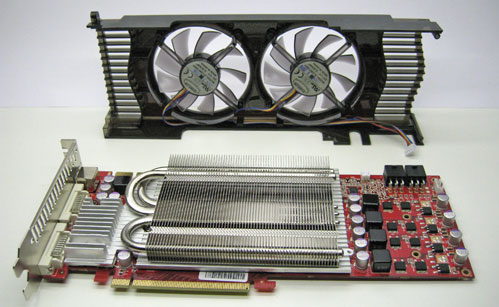
The Golden Sample GTX 260 cooler uses two 8cm diameter fans. The fans are mounted on the plastic hood, which is separated from the rest of the cooler.
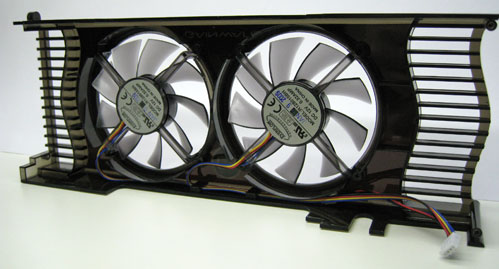
We see that powering both fans is done via the same cable, which is connected to the 4-pin pinhead connector at the end of the PCB. This way they can both be easily controlled, but both spin at same speeds.
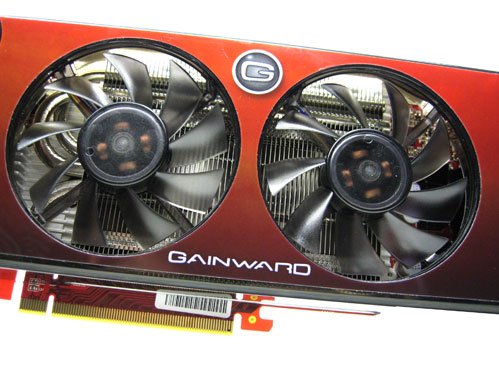
Since this is a card with one graphics processor, both fans are placed in a way to equally distribute air over the GT200 GPU and one heatsink.
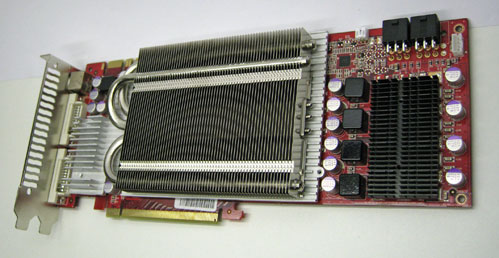
A large heatsink with three heatpipes covers the most of the card’s surface, but it only touches the core.
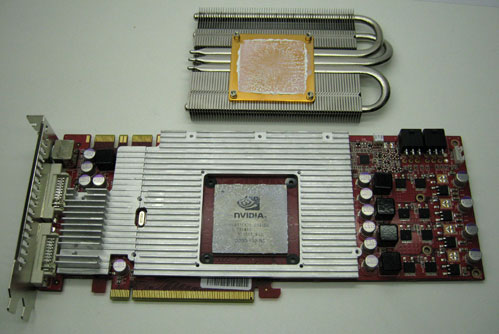
Underneath the heatsink, you’ll find a large aluminum block covering the memory and the rest of the important components, such as the NVIO chip responsible for handling the picture and the memory voltage regulators.
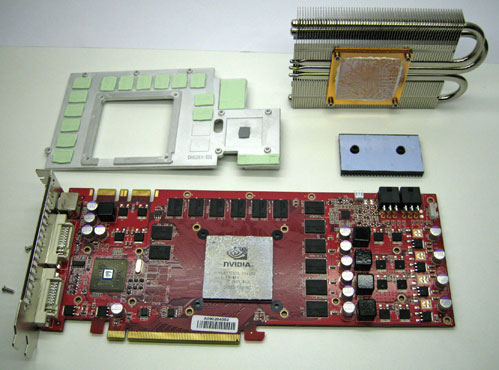
Gainward uses a non-reference PCB with 4+1 phase PWM design, and if you look at the end of the card, you’ll find a small black heatsink responsible for cooling the power-circuitry’s regulators. As you already might’ve noticed, the memory power components got relocated to the opposite side.
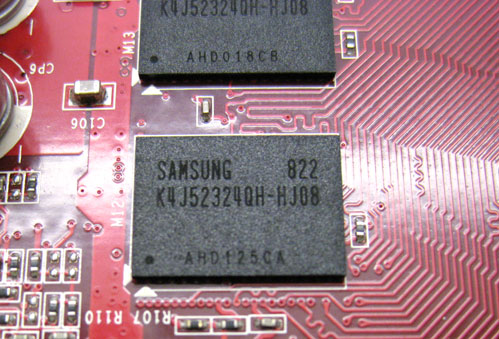
The memory is located underneath the aluminum block, which is nicely cooled by the fan. The frame buffer has 896MB of GDDR3 memory running at 1100MHz (2200MHz effectively). The reference card’s bandwidth is 111.9GB/s, whereas Gainwards card features a bandwidth of 123.2GB/s.
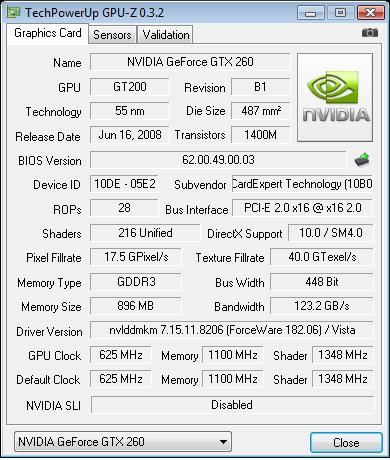
The graphics processor runs at 625MHz, which is 50MHz higher than reference. The rest of the important specifications can be viewed on the GPUZ picture.
Apart from PCI-Express’ power, the card will need two 6-pin power connectors which are located on top corner of the card, just like on the reference card.
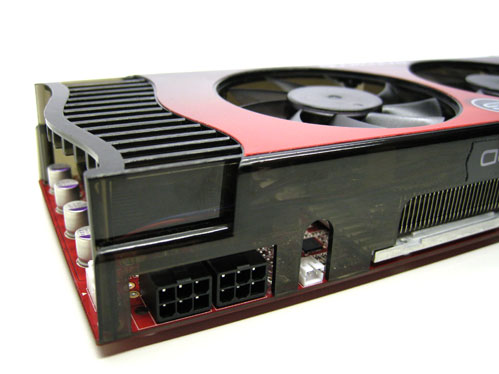
If you crave more performance, you can always combine one or two more cards, connecting them with two provided SLI connectors.
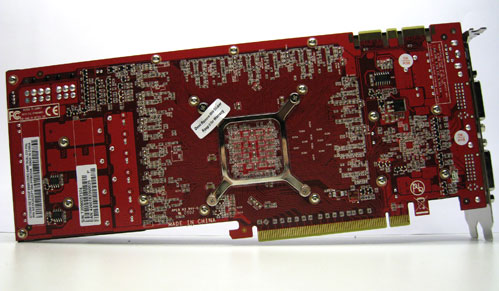
The I/O panel features one TV-out and two dual-link DVIs with HDCP, and you can use them as an HDMI out with the provided DVI-to-HDMI adapter. You’ll also get a SPDIF cable, and you’ll need it if you want to use one cable to bring both video and audio to your HD TV. This is a standard thing with Nvidia’s cards, and you’ll be connecting one end of the cable to the connector next to the power connectors, and the other one to the SPDIF out on the motherboard.
The packaging is a bit large for our taste, but at least it keeps the card safe. We must admit that this is the first time we received 3DMark Vantage as a gift. Actually, you’ll get an activation code, whereas the software will have to be downloaded from Futuremark’s site.
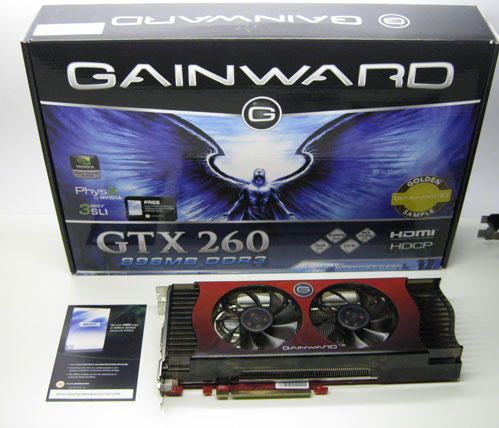
Apart from the graphics card, in the box you’ll also find standard cables and the DVI-to-HDMI converter with an SPDIF cable. You’ll also get a user’s manual and driver CD.
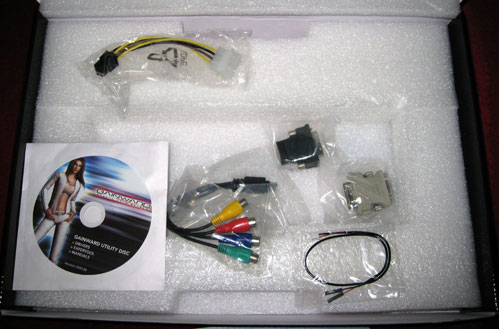
Testbed
Motherboard: MSI P45D3 Platinum ( Provided by: MSI );
Processor: Intel Core 2 QX9770 Extreme edition na 3.6GHz ( Provided by: Intel );
Memory: Corsair Dominator 12800 7-7-7-24 ( Provided by: Corsair);
HDD: WD VelociRaptor 300G 10,000RPM ( Provided by: SmoothCreation );
Geforce driver 182.06 / Catalyst 9.2
Vantage Tests
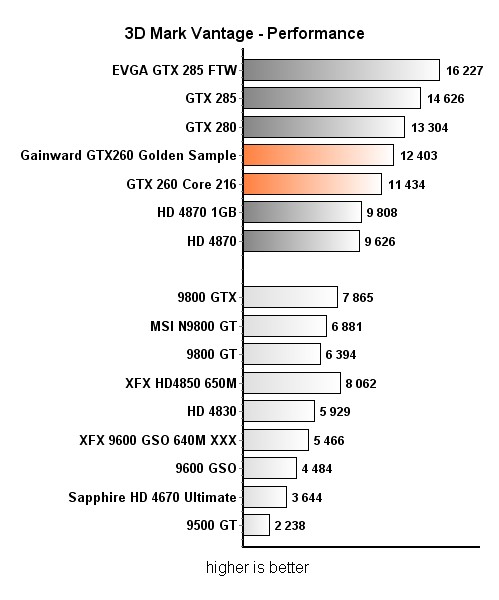
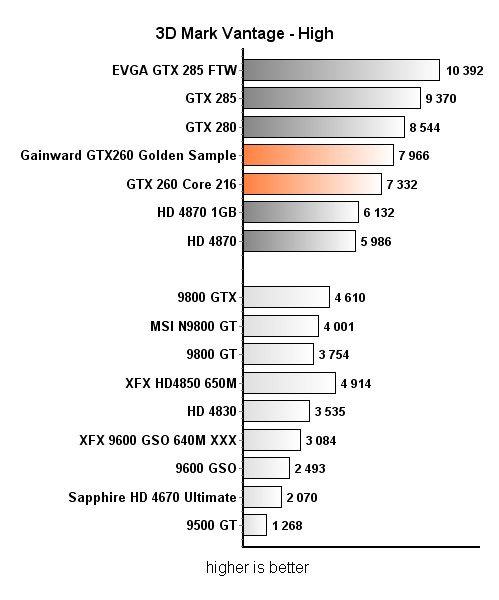
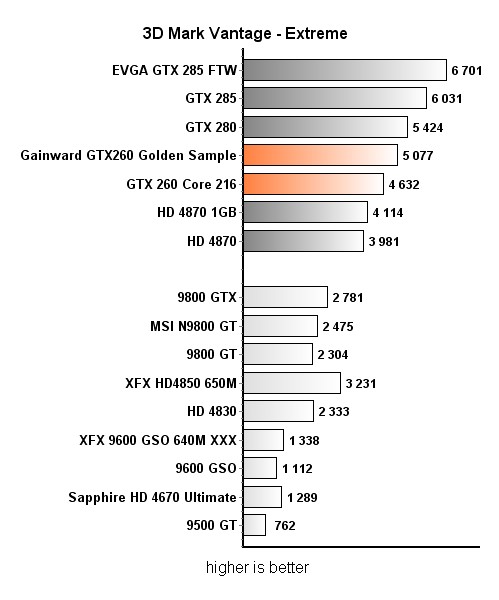
Gainward's GTX 260 GS was off to a good start, beating the reference card by 8.5% at performance and high settings, whereas extreme settings extend this advantage to 9.6%.
Far Cry 2
FarCry 2 sees Gainward’s GTX 260 Golden Sample fill the gap between the reference GTX 260 and the GTX 280 card.
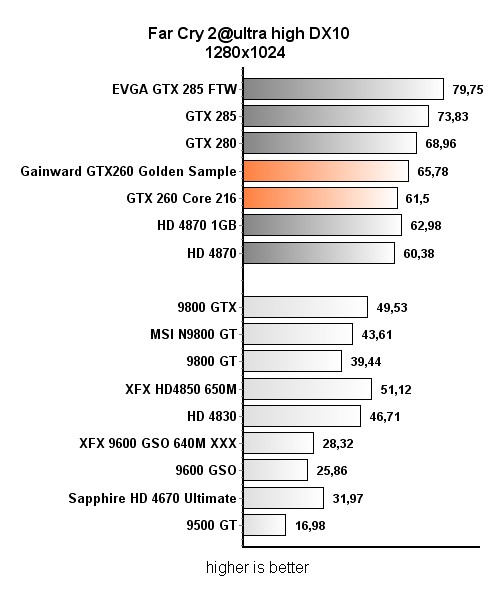
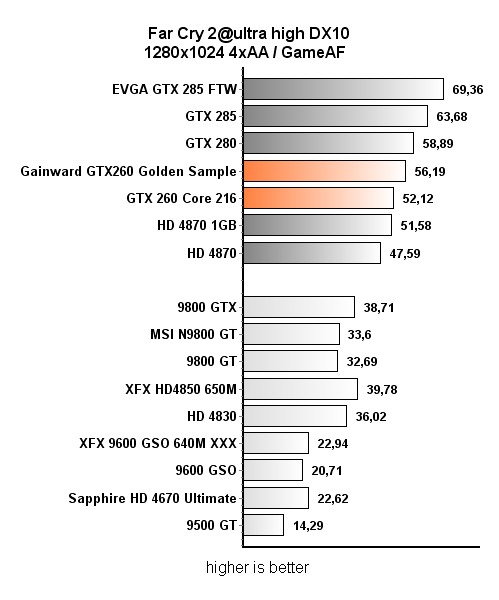
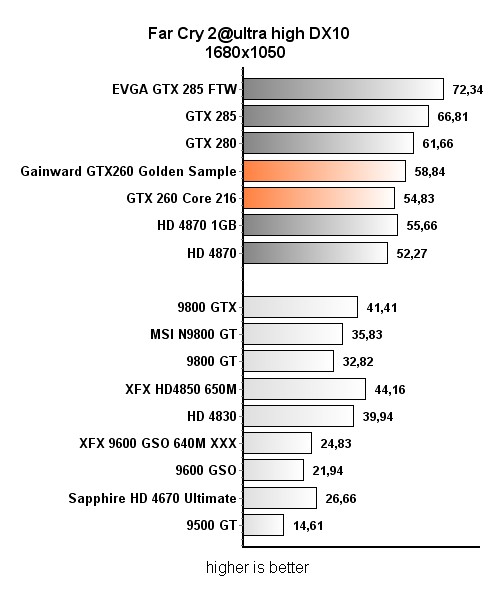
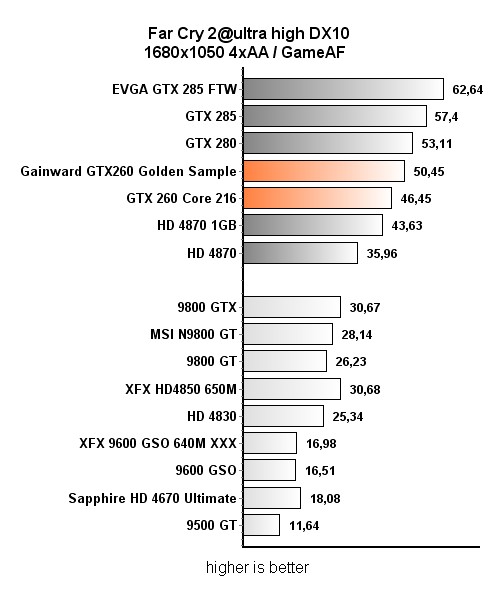
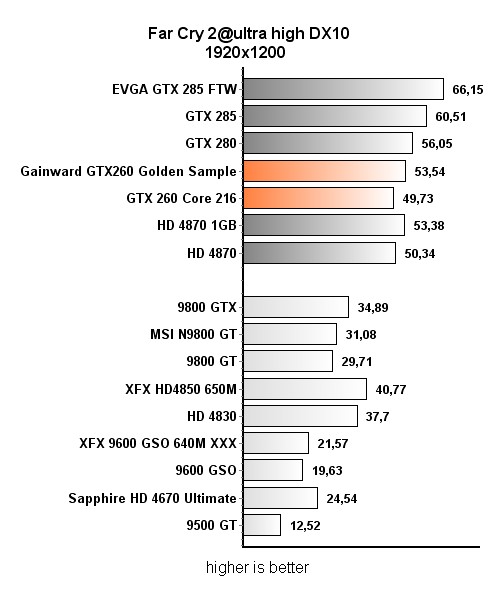
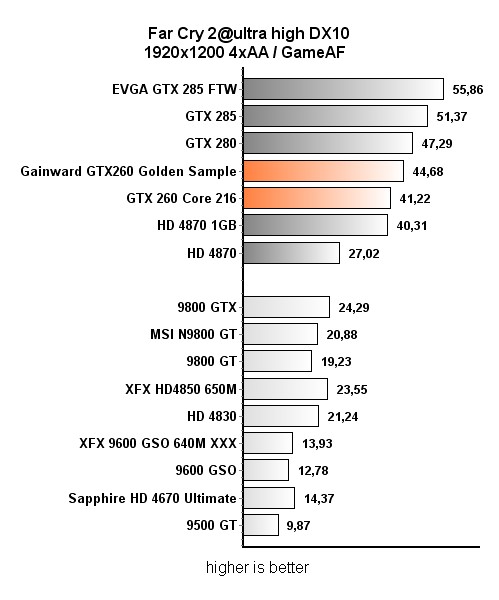
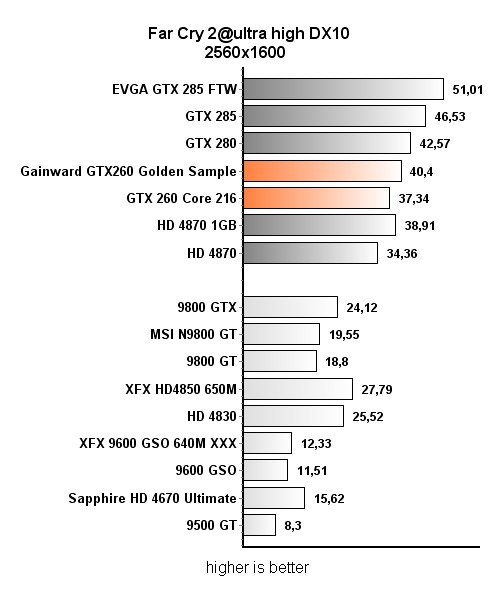
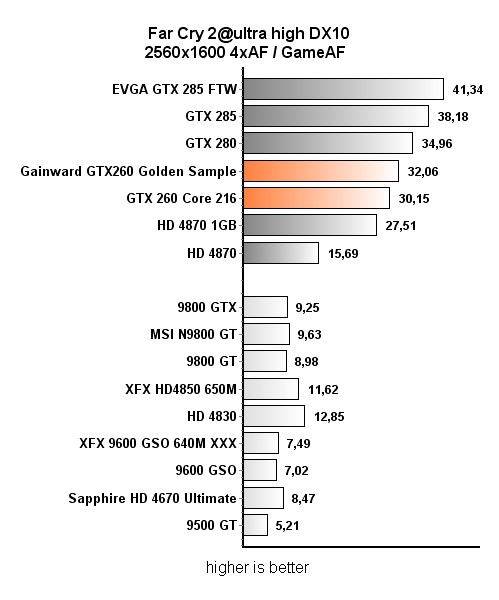
Gainward’s results were about 8% better than those scored by the reference GTX 260, which shows that performance scales well with overclocking, as the overclocking was just a bit higher than 8%. Radeon HD 4870 1GB managed to squeeze out a couple of frames more than reference GTX 260, but it didn’t beat the overclocked GTX 260 GS once.
World in Conflict


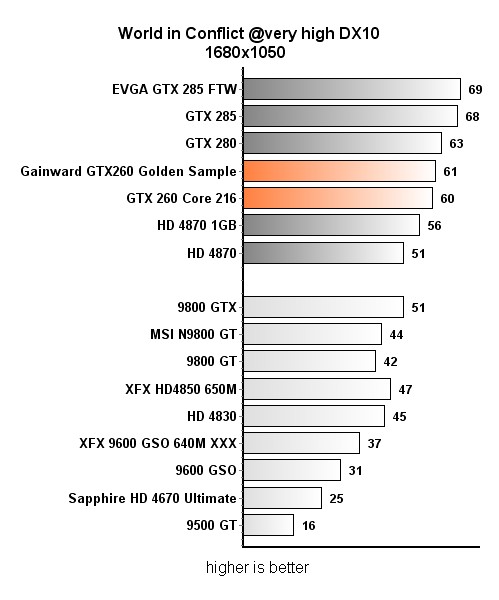
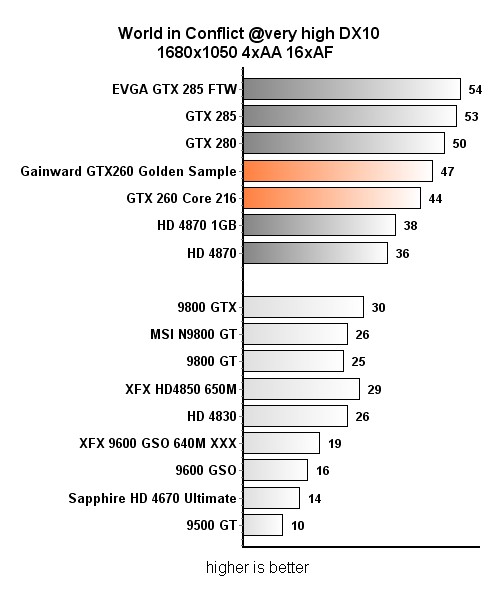
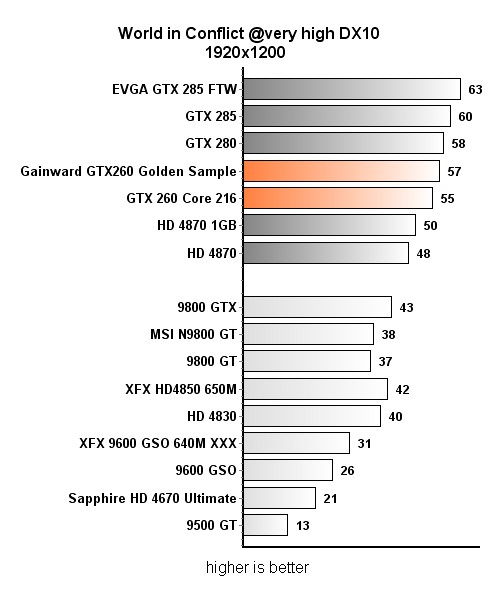
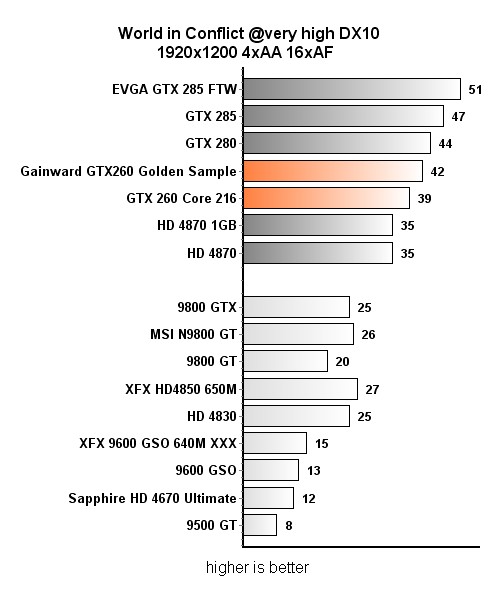
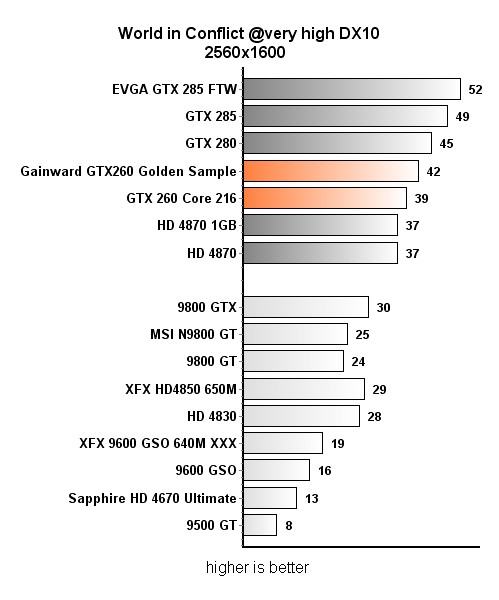
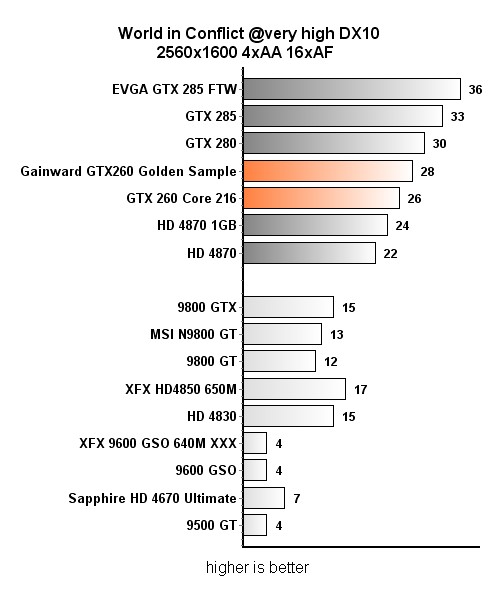
Gainward constantly beats the reference GTX 260, and the situation is much like in the previous test, where the maximum score advantage is about 8%.
Left 4 Dead








Consumption
As far as consumption goes, if you value every watt, you should know that Gainward’s card consumes more than the reference card. This is due to the lack of 2D/3D clock switch on the card, so it always runs at maximum speeds. At the same time, the reference card in idle mode will run at 300MHz GPU, 600MHz shader, while the memory will downclock to mere 100MHz (200MHz effectively).
During our testing, our test-rig containing the Golden Sample card consumed up to 299W, whereas the reference card resulted in 270W. The consumption difference in 2D mode didn’t go in Gainward’s favor either, as our rig with the Golden Sample used up about 127W, whereas the rig containing the reference card consumed about 105W.
Overclocking
We played with Gainward GTX 260 Golden Sample using Nitro overclocking tool, and we managed to push it to 720MHz for the GPU and 1225MHz (efective 2450MHz) for the memory. For more details look here.

Conclusion
It's not every day that you see a card that's priced this close to reference card, and at the same time packs non-reference cooling. Add to that the fact that the card comes overclocked and we clearly have a winner on our hands. The cooling does a great job and since similar cooling was previously employed to cool Gainward's HD 4870 X2, you can rest assured that it will keep the card cool.
The only thing where this card falls short is its idle mode consumption. The card doesn’t use the 2D/3D clock switcher and it results in higher consumption than on reference cards. On the other hand, if you’re not concerned with consumption and aren’t stressing over every watt spent, you’ll probably find this to be a minor thing.
215 euro buys you a card that runs cool while overclocked, and will definitely do you a world of good in playing popular and muscle-hungry titles. However, you should hurry, as only a couple of these cards are left on the shelves here.



